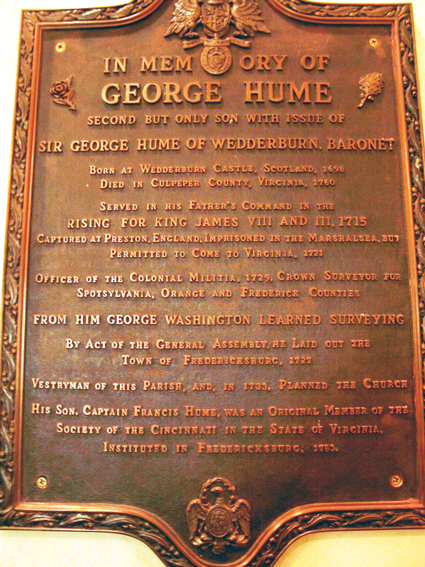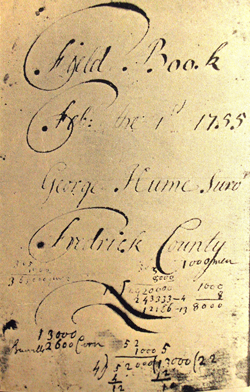
Many people will never see this plaque. When you come in the “big red door” and go inside the narthex look to the right wall behind the door you will see this large plaque. The Hume memorial should be near the streets he helped to survey but also inside the Church with his contributions to the early St. George’s history. The plaque was placed here in May, 1938 by Col. Erskine Hume, a direct descendant and who served in three wars. The dedication was June 26, 1938.
The weight of this plaque is staggering. This is also by far the most popular plaque we have. During the renovation I stored it (with just a few other things) in my office, always toward the back due to its weight. On at least three occasions I had to drag it out for people who had come to St. George’s especially to see this plaque. This doesn’t count at least two separate phone calls on Mr. Hume. (Note that his name is sometime written “Home” and other times “Hume” but it is pronounced as “Hume.”)
As with many people in St George’s early 18th century history, Hume was not a native. Born in 1698 at Wedderburn Castle in Scotland, the family home for 600 years, Hume came here by accident. He served under the command of his father in 1715 in the losing cause to support James III (called the “Old Pretender”) son of the deposed king James II of England in his effort to claim the throne of England, Scotland and Ireland.
Captured and imprisoned, Hume served two years in prison. When he was released there were few opportunities open for a convict and a second son. An additional problem was that he was out of favor with his brother-in-law Rev. Ninian Hume who was reorganizing the family property. Hume was permitted to come to Virginia in 1721 as an indentured labor which was a break for him after prison.
Shortly after arriving, he went to Williamsburg to be under the care of a doctor who was another Scottish exile. He also had relatives in high places as his cousin Alexander Spotswood was governor of Virginia who had freed his uncle Francis Hume, but by the time Hume recovered Spotswood was out of office. George had studied mathematics in Scotland, and so while in Williamsburg was sent to the College of William and Mary and was accredited by it as a surveyor.
By 1725 he moved to the new county of Spotsylvania. On August 13, 1728, George made the first survey of Fredericksburg when he laid out the 64 original lots from 50 acres. With a marriage dower of 2000 lands in marriage to Elizabeth Proctor, he took up residence here to market his profession. Hume became a member of our Vestry in 1729 having served as a reader in another church. Our Vestry minutes report that along with Benjamin Cave he was appointed to count tobacco plants. Despite serving against the English, he was commissioned a lieutenant in the colonial militia, possibly because they needed able bodied men to handle disputes with the Indians.
Hume was hired in June, 1733 to “set the Church in Fredericksburg East and West” as required by Anglican Law and received 100 pounds of tobacco as his payment. This is our first building which we date from 1735 when we paid the sexton. In October 1735, Hume recorded a deed to a 929 acre Spotsylvania County property division near Fredericksburg. This particular division helped form the framework for many of Fredericksburg’s 19th century neighborhoods.
Hume life’s was constantly on the go. Hume had the knack for getting in various disputes as recorded in Spotsylvania county records and there are those who question his ability as surveyor. William Waller revealed errors in Hume’s original city layout since it “appropriated too much waterfront footage at each end and encroached on adjoining patents.”
Hume moved on to Orange County and became a deputy surveyor there in 1739 after that county was split from Spotsylvania in 1734 and advanced to become the official surveyor in 1751. By this time the land he owned was part of the new county of Culpeper which had been separated in 1747. Life was difficult. One letter in 1748 complained of sickness and the “long, tedious journeys of where we are obliged to go perhaps several months without seeing a house and living together altogether on wilde meat.”

It was during these years he encountered George Washington. The Church plaque indicates that Washington learned surveying through Hume. It may be closer to the truth that they collaborated on assignments and that Washington furthered his knowledge through Hume and at least with other two other individuals. Hume employed Washington as a deputy in 1748 in the survey of the George Carter estate and they surveyed lands that later became Augusta and Frederick counties, including the boundary which is still used today. (See the title page from his Frederick County field book to the left). He served on the recommendation of Washington as the third of three arbiters in the claims of Lord Thomas Fairfax to the Culpeper grant (a relative of his). Hume had been involved in the early surveying of these lands in 1733.
Washington went on to be employed as a surveyor from Culpeper in 1749 and established the Rapidan River as the boundary dividing the counties of Orange and Culpeper. In 1751, Hume was appointed a crown surveyor. All the while Hume not laid out land but was acquiring it at the same time and received 3 grants from Lord Fairfax.
Hume died in Culpeper County in 1760. While Hume’s focus was on the developing counties, Fredericksburg was never far away as he used one William Hunter, a merchant in Fredericksburg as his mailing address. Hunter had a relative in Scotland who lived about a mile and half from Wedderburn Castle.
